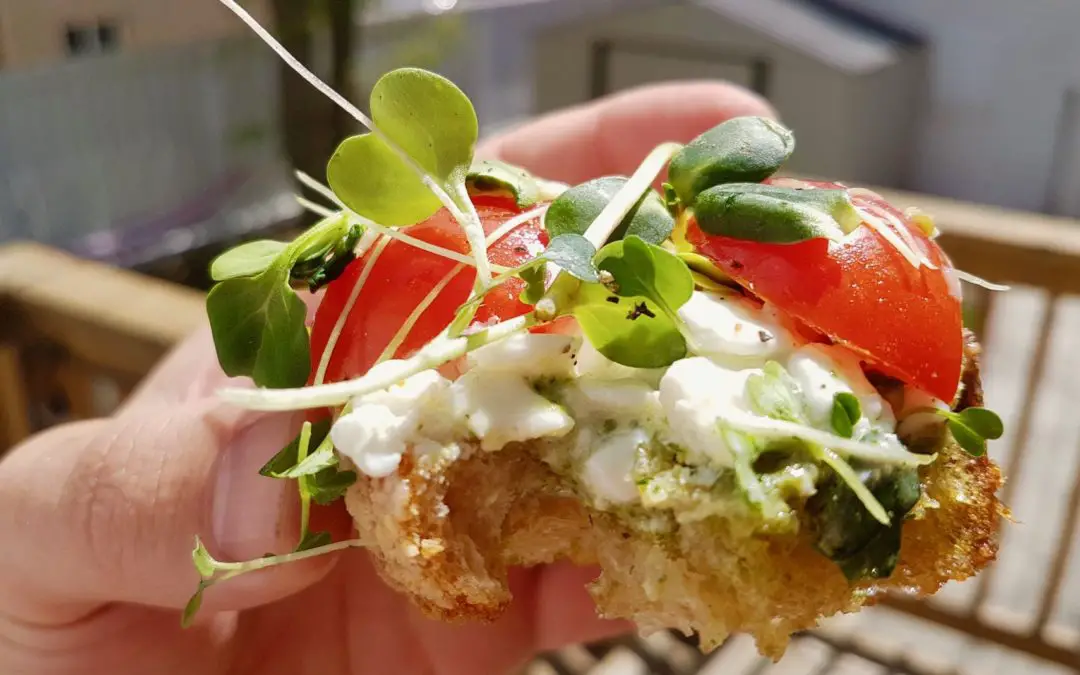Eating microgreens is an easy way to increase your antioxidant, vitamin, and nutrient intake without consuming huge volumes of vegetables.
Microgreens are the freshest leafy-green vegetables you can eat, and they’re easier and more affordable to grow than ever.
Eating microgreens is an easy way to support local, add flavor to your cooking, increase vitamin and healthy plant-compound intake, and they’re even suitable for keto or low carb diets.
Let’s dig into some of the reasons you might want to order a few microgreen seeds today, or stop by the local market.
Supporting Local
Buying from local farmers and businesses reduces transportation, increases diversity and competition in the market, and usually means you get higher quality food.
Microgreens specifically are best eaten fresh. Fruits and Vegetables, and greens in particular
And if you’re growing yourself, that’s as local as possible!
More people are living in cities than ever before. Urban farmers are well-positioned to provide local, nutrient-dense food. And there’s a steady increase in average food prices (while a lot of staple are relatively constant). This means a lot of people are willing to pay a premium for high quality food.
Farming in an urban setting opens up all kinds of possibilities that might not be apparent at first sight. You need less land, less money, and less space to get started than you might think. The odds are stacked in your favor.
They have a huge range of Flavors
Spicy, sweet, crunchy, nutty: all these flavors and textures and more are available from microgreens, you just need to get out there and start trying different ones.
What do microgreens taste like? It depends!
I put together some quick lists to help you find your favorite flavors.
Spicy Microgreens
- Radish
- Mustards
- Arugula
Sweeter and Tender
- Pea Shoots
- Beets
Nutty & More Substantial
- Sunflower shoots
Mild Flavored
- Broccoli
- Chard
- Mizuna
- Cabbage
- Kale
Citrus or Lemony
- Lemon Basil
- Sorrel
- Lemon Mint
- Lemon Balm
They’re Healthy, really Healthy
Microgreens have been shown to contain high levels of key nutrients, vitamins, and beneficial phyto-compounds. They have even been shown to contain compounds that reduce disease.
The microgreen I’m most interested in from a health perspective is broccoli because it contains sulforaphane.
You can read more about the incredible health effects, and how they benefit from freezing in this article. Here’s the quick version:
Sulforaphane is widely studied, and has been shown to have a number of benefits:
- Antioxidant (source)
- Antimicrobial (source)
- Anticancer (source)
- Anti-inflamatory (source)
- Anti-aging (source)
- Neuroprotective (source)
- Antidiabetic (source)
And sulforaphane-containing microgreens aren’t the only ones with health benefits, all microgreens contain elevated levels of nutrients compared to their mature vegetable counterparts.
Most Nutrient Dense Microgreens
Microgreen | Nutrients | Flavor |
Broccoli | Sulforaphane, beta carotene, vitamin B & C, amino acids | Mild, Fresh Cabbage |
Red Cabbage | Vitamins E & C | Sweet Cabbage, Spicy Aftertaste |
Pea Shoots | Folate | Sweet and Mild |
Radish | Essential Amino Acids | Spicy, Potent |
Sunflower | Complete Plant Protein, Zinc | Nutty, Substantial |
Arugula | Glucosinolates, Vitamin C (ascorbic acid), Phenols | Peppery |
Basil | Polyphenols | Fresh, Herby, like Mature Basil |
Cost Effective
Buying microgreens can seem expensive, but once you factor in up to 25 times the nutrient density of mature vegetables, you can effectively divide the price by 25. That’s a pretty good deal.
But you can’t just consider nutrient density, you still want a full bowl of salad, or a nice crunchy sandwich full of microgreens.
So what’s the best way to eat microgreens cost effectively?
Grow your own!
All you really need to get started are high quality seeds, but some high quality soil
Sustainability
It’s easy to find microgreens unstainable at first glance. Bright lights, throwing out soil after one crop, ordering and shipping specialized seeds.
But microgreens are sustainable for a number of reasons.
They’re nutrient dense, microgreens can contain up to 25 times as many nutrients as their more mature counterparts. That means that any microgreens you harvest are equivalent to 25 times their mature versions, or another way to look at it, is that they use 25 times less resources for the same nutritional content.
Microgreens are also really efficient on water. A carefully dialed-in grow can use as little as 5 quarts (5 liters) of water for a whole 10” x 20” tray, even less if you really optimize.
Mature greens need to be watered over and over again, washed, and fertilized and the list goes on. The water use really adds up.
If you’re buying microgreens, look for compostable or recyclable packaging, some are even both! And make sure the labels are easy to remove, really difficult to remove labels can cause recycling facilities to reject the packaging. Read up on a really difficult situation with recycling here.
Growing your own is Incredibly Satisfying
Growing your own microgreens reconnects you to nature and to your food.
The feeling of picking a fresh cherry tomato in the garden and popping it into your mouth, you get that same satisfaction with microgreens.
Farming used to be brutal low paid work, a race to the bottom. Values are changing, especially what people value in their food: nutritional density, origin, local, growing practices, and community impact. Growing microgreens builds on a lot of these trending values.
Growing microgreens, and sharing them with your community is an incredible way to re-connect with friends and family.
I’ve been growing microgreens for both of my parents and it’s been really meaningful for me to be able to help them be healthy and freshen up their diets as they age.
Self Sufficiency
By having a stock of seeds, you’re self-sufficient for your microgreens. In all but the most extreme climates, there’s a way to get soil, and water. Then you have the capability to dramatically increase the nutrients in your diet, without leaving home.
All you need are seeds.
During the recent Covid-19 crisis, microgreen seeds worldwide saw an enormous surge in demand. All of my usual go-to online shops were 50 – 75% sold out of different sprouting and microgreen seed varieties.
All the more popular and easy-to-grow ones were completely sold out.
This speaks to the usefulness of microgreen seeds in emergency situations. People across the world turned to microgreens to boost their diets, and access food without being able to go to supermarkets (without risk).
I’m not a very doom-and-gloom type of person, but there’s an argument to be made that having a supply of seeds on standby, properly stored, prepares you and your family for the future.
And they don’t have to just sit there and take up space. If you’re constantly growing microgreens you’re keeping your skills sharp, and cycling through your seed stockpile so your seeds are always fresh and will last the longest time if there is another supply chain disruption in the future.
I know I’m going to keep a bigger buffer than I did in the past, I almost ran out of microgreen seeds last month in April 2020.
Maybe you should consider stockpiling just a little, too.
Finishing up
Microgreens are worth eating because they’re the most cost-effective way to boost your nutrient intake. They’re sustainable, incredibly dense in nutrients and beneficial compounds, and may actually reduce certain diseases.
There are a ton of ways to incorporate them into your diet, and the range of textures and flavors is truly immense.
I hope I gave you one or two more reasons to try microgreens, branch out into new varieties, or maybe even start growing your own!
Related Articles
If you’re eating or growing microgreens, you might be concerned on how to buy or grow them organically, I did some research and laid out steps for determining if the microgreens at the store are organic or not, and steps you should take to grow organically yourself.
Are Microgreens Organic? It Surprised me to Learn… (Lins to Article)
If you’re on a ketogenic diet, you might consider upping your microgreen intake, but some microgreens are more keto than others.
Are Microgreens Keto? Low Carb, High Nutrients (Links to Article)
Sources
- Nutritional comparison of fresh, frozen and canned fruits and vegetables. Part 1. Vitamins C and B and phenolic compounds (JC Rickman et al. 2007)
- SULFORAPHANE POTENTIAL AND VITAMIN C CONCENTRATION IN DEVELOPING HEADS AND LEAVES OF BROCCOLI (BRASSICA OLERACEA VAR. ITALICA … (MB Omary et al. 2003)
- ASCORBIC ACID CONTENT OF BROCCOLI DURING MARKETING1 (DE Hudson et al. 1986)
- Mild Microgreen Mix – True Leaf Markets
- Spicy Salad Mix – Microgreen Seeds – True Leaf Markets
- Tiny Microgreens Packed with Nutrients – Jennifer Warner Web MD 2012
- Micro citrus mix – Specialty Produce
- Microgreens: Assessment of Nutrient Concentrations (G. Lesler 2013)

I’m Alex Lafreniere. I learned a lot about plants when I built and operated a landscaping company. I learned even more when I started growing and selling Microgreens. But, learning is a journey, not a goal. Ever since travelling across the world, I’ve wanted to find ways to bring more delicious and exotic plants into my life. This is the site where I share everything I’ve learned with you. And maybe we’ll learn a thing or two together.
This site is owned and operated by Plant Hardware, a sole proprietor headquartered in Calgary, Canada. Plant Hardware is a participant in the Amazon Services LLC Associates Program, an affiliate advertising program designed to provide a means for sites to earn advertising fees by advertising and linking to Amazon.com. Plant Hardware may also participate in affiliate programs with Bluehost, Clickbank, CJ, ShareASale, and other sites. Plant Hardware is compensated for referring traffic and business to these companies.

